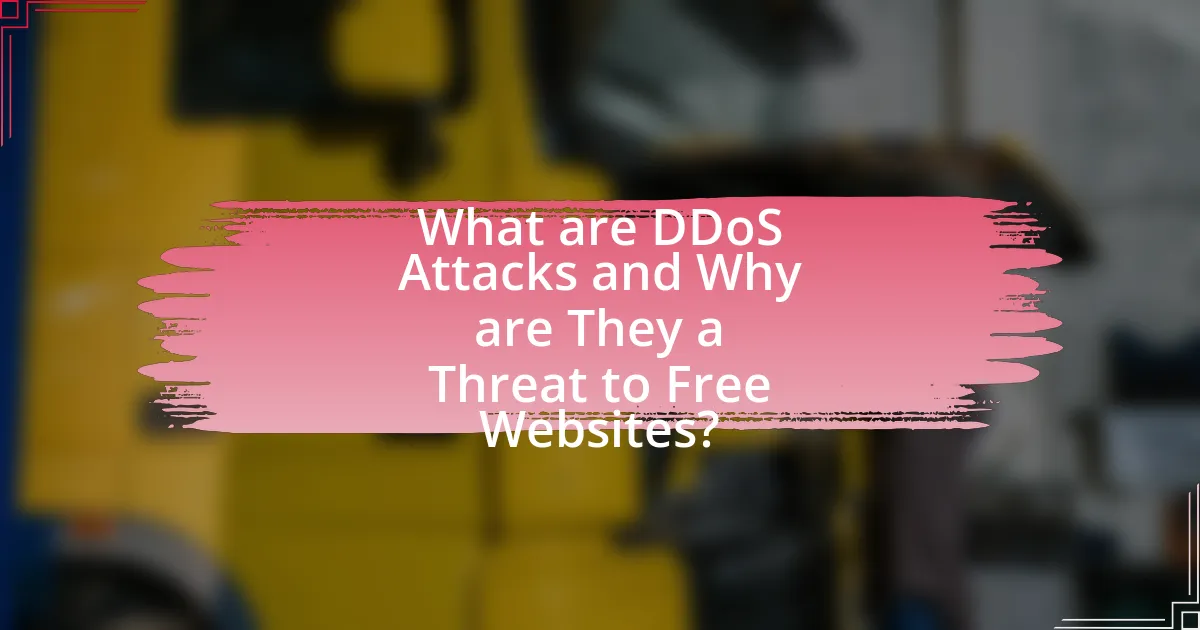DDoS attacks, or Distributed Denial of Service attacks, are a significant threat to free websites, as they overwhelm targeted servers with excessive traffic, leading to downtime and loss of accessibility for legitimate users. This article outlines the mechanics of DDoS attacks, the various types and methods employed, and the specific vulnerabilities of free websites due to limited resources and inadequate security measures. It also provides effective strategies for securing free websites against these attacks, including the implementation of traffic filtering, rate limiting, and the use of Content Delivery Networks (CDNs). Additionally, the article emphasizes the importance of regular monitoring, strong password policies, and timely software updates to enhance overall website security.

What are DDoS Attacks and Why are They a Threat to Free Websites?
DDoS attacks, or Distributed Denial of Service attacks, are malicious attempts to disrupt the normal functioning of a targeted server, service, or network by overwhelming it with a flood of internet traffic. These attacks pose a significant threat to free websites because they can exhaust the limited resources available to such sites, leading to downtime and loss of accessibility for legitimate users. According to a report by Cloudflare, 70% of DDoS attacks target small businesses, which often rely on free hosting services that lack robust security measures. This vulnerability can result in financial losses, damage to reputation, and a decrease in user trust, making it crucial for free website owners to implement protective measures against these attacks.
How do DDoS attacks work?
DDoS attacks work by overwhelming a target server, service, or network with a flood of internet traffic, rendering it unable to respond to legitimate requests. Attackers typically use a network of compromised devices, known as a botnet, to generate this excessive traffic. For example, in 2018, the GitHub platform experienced a DDoS attack that peaked at 1.35 terabits per second, demonstrating the scale at which these attacks can occur. The sheer volume of requests sent by the botnet saturates the target’s bandwidth or exhausts its resources, leading to service disruption or complete shutdown.
What types of DDoS attacks exist?
There are several types of DDoS attacks, including volumetric attacks, protocol attacks, and application layer attacks. Volumetric attacks, such as UDP floods and ICMP floods, aim to overwhelm the bandwidth of the target by sending massive amounts of traffic. Protocol attacks, like SYN floods and Ping of Death, exploit weaknesses in network protocols to disrupt service. Application layer attacks, such as HTTP floods, target specific applications or services to exhaust server resources. Each type of attack has distinct characteristics and methods of execution, making them effective in different scenarios.
What are the common methods used in DDoS attacks?
Common methods used in DDoS attacks include volumetric attacks, protocol attacks, and application layer attacks. Volumetric attacks, such as UDP floods and ICMP floods, overwhelm the target with excessive traffic, consuming bandwidth and resources. Protocol attacks, like SYN floods, exploit weaknesses in network protocols to disrupt service availability. Application layer attacks, such as HTTP floods, target specific applications to exhaust server resources. According to the 2023 DDoS Threat Landscape report by Cloudflare, volumetric attacks accounted for 70% of all DDoS incidents, highlighting their prevalence and impact.
Why are free websites particularly vulnerable to DDoS attacks?
Free websites are particularly vulnerable to DDoS attacks due to their limited resources and lack of robust security measures. Many free hosting services do not provide adequate bandwidth or server capacity, making them easier targets for attackers who can overwhelm these sites with traffic. Additionally, free websites often lack advanced security features, such as DDoS protection and traffic filtering, which are typically available to paid services. This combination of insufficient resources and inadequate security makes free websites more susceptible to disruptions caused by DDoS attacks.
What limitations do free websites have that increase risk?
Free websites often have limitations such as lack of security features, limited bandwidth, and unreliable uptime, which increase the risk of DDoS attacks. These platforms typically do not offer robust protection against malicious traffic, making them vulnerable to overwhelming requests that can lead to service outages. Additionally, free hosting services may impose bandwidth restrictions, causing websites to crash under high traffic loads, whether legitimate or malicious. Furthermore, the absence of dedicated support means that issues arising from attacks may not be resolved promptly, exacerbating the risk of prolonged downtime.
How does the lack of resources affect DDoS mitigation?
The lack of resources significantly hinders DDoS mitigation efforts by limiting the ability to deploy effective countermeasures. Without sufficient bandwidth, processing power, or financial investment, organizations struggle to absorb or redirect malicious traffic, making them more vulnerable to prolonged attacks. For instance, a study by the Ponemon Institute found that 60% of organizations reported that inadequate resources directly impacted their ability to respond to DDoS attacks effectively. This resource deficiency can lead to increased downtime, loss of revenue, and damage to reputation, as the organization cannot implement advanced security solutions or maintain adequate incident response teams.

What are Effective Strategies for Securing Your Free Website Against DDoS Attacks?
To secure your free website against DDoS attacks, implement a combination of traffic filtering, rate limiting, and leveraging a Content Delivery Network (CDN). Traffic filtering allows you to identify and block malicious requests before they reach your server, while rate limiting restricts the number of requests a user can make in a given timeframe, effectively mitigating the impact of an attack. Utilizing a CDN distributes your website’s traffic across multiple servers, reducing the load on any single server and enhancing resilience against DDoS attacks. According to a report by Cloudflare, websites using CDNs can experience up to a 70% reduction in attack traffic, demonstrating the effectiveness of these strategies.
How can you enhance your website’s security settings?
To enhance your website’s security settings, implement a Web Application Firewall (WAF) to filter and monitor HTTP traffic between a web application and the Internet. A WAF can protect against various attacks, including DDoS, by blocking malicious traffic before it reaches your server. According to a report by the Ponemon Institute, organizations that deploy WAFs can reduce the risk of data breaches by up to 50%. Additionally, regularly updating software and plugins, using strong passwords, and enabling HTTPS can further secure your website against vulnerabilities.
What security features should you enable on your website?
To secure your website against DDoS attacks, you should enable features such as a Web Application Firewall (WAF), DDoS protection services, SSL/TLS encryption, and rate limiting. A Web Application Firewall filters and monitors HTTP traffic to and from your web application, providing a barrier against malicious traffic. DDoS protection services, like those offered by Cloudflare or Akamai, absorb and mitigate large-scale attacks, ensuring your website remains accessible. SSL/TLS encryption secures data in transit, protecting sensitive information from interception. Rate limiting controls the number of requests a user can make in a given timeframe, preventing abuse and reducing the risk of overwhelming your server. These features collectively enhance your website’s resilience against DDoS attacks, ensuring better uptime and security.
How can you configure your firewall to protect against DDoS attacks?
To configure your firewall to protect against DDoS attacks, implement rate limiting to control the number of requests from a single IP address. This method helps mitigate the impact of excessive traffic by allowing only a specified number of requests over a defined time period. Additionally, enable IP blacklisting to block known malicious IP addresses and utilize deep packet inspection to analyze incoming traffic for suspicious patterns. According to a report by the Cybersecurity & Infrastructure Security Agency (CISA), these strategies can significantly reduce the effectiveness of DDoS attacks by filtering out harmful traffic before it reaches your server.
What role do third-party services play in DDoS protection?
Third-party services play a crucial role in DDoS protection by providing specialized tools and infrastructure designed to mitigate and absorb large-scale attacks. These services utilize advanced techniques such as traffic filtering, rate limiting, and load balancing to identify and block malicious traffic before it reaches the target website. For instance, companies like Cloudflare and Akamai offer DDoS mitigation solutions that can handle traffic spikes and ensure website availability during an attack, evidenced by Cloudflare’s ability to mitigate attacks exceeding 1.5 Tbps. By leveraging the expertise and resources of these third-party providers, organizations can enhance their security posture and maintain operational continuity in the face of DDoS threats.
Which DDoS protection services are recommended for free websites?
Cloudflare offers a recommended DDoS protection service for free websites, providing a robust solution against various types of DDoS attacks. It includes features like a Web Application Firewall (WAF) and automatic traffic filtering, which help mitigate threats effectively. Additionally, services like Sucuri and Incapsula also provide free tiers that can assist in protecting free websites from DDoS attacks, ensuring that users have access to essential security measures without incurring costs.
How can content delivery networks (CDNs) help mitigate DDoS attacks?
Content delivery networks (CDNs) help mitigate DDoS attacks by distributing incoming traffic across multiple servers, thereby reducing the load on any single server. This distribution allows CDNs to absorb and filter out malicious traffic before it reaches the origin server, effectively minimizing the impact of the attack. For instance, Akamai, a leading CDN provider, reported that their network can handle over 100 terabits per second of traffic, which enables them to withstand large-scale DDoS attacks. Additionally, CDNs often employ advanced security measures, such as rate limiting and traffic analysis, to identify and block suspicious activity, further enhancing their ability to protect websites from DDoS threats.

What Best Practices Should You Follow to Maintain Website Security?
To maintain website security, implement strong password policies, regularly update software, and utilize HTTPS. Strong passwords reduce the risk of unauthorized access; for instance, using complex passwords can decrease the likelihood of brute-force attacks. Regular software updates patch vulnerabilities, as evidenced by the fact that 60% of breaches involve unpatched software. Utilizing HTTPS encrypts data in transit, protecting sensitive information from interception. Additionally, employing a Web Application Firewall (WAF) can help filter and monitor HTTP traffic, providing an extra layer of security against attacks.
How can regular monitoring help in DDoS attack prevention?
Regular monitoring can significantly enhance DDoS attack prevention by enabling early detection of unusual traffic patterns. By continuously analyzing network traffic, organizations can identify spikes or anomalies that may indicate an impending DDoS attack. For instance, a study by the Ponemon Institute found that organizations with real-time monitoring capabilities can reduce the impact of DDoS attacks by up to 50%. This proactive approach allows for timely responses, such as implementing rate limiting or redirecting traffic, which can mitigate the attack’s effects before they escalate.
What tools can you use for monitoring website traffic?
Google Analytics is a widely used tool for monitoring website traffic. It provides detailed insights into user behavior, traffic sources, and demographics, allowing website owners to analyze their audience effectively. Additionally, tools like Matomo offer similar functionalities with a focus on data privacy, while SEMrush provides traffic analysis alongside SEO tools. These tools are validated by their extensive user bases and the comprehensive data they offer, making them reliable choices for monitoring website traffic.
How often should you review your website’s security measures?
You should review your website’s security measures at least quarterly. Regular reviews help identify vulnerabilities and ensure that security protocols are up to date with the latest threats. According to a study by the Ponemon Institute, organizations that conduct regular security assessments are 50% less likely to experience a data breach. This frequency allows for timely updates and adjustments to security strategies, particularly in response to evolving DDoS attack methods.
What are the common mistakes to avoid when securing your website?
Common mistakes to avoid when securing your website include neglecting regular software updates, using weak passwords, and failing to implement HTTPS. Regular software updates are crucial as they patch vulnerabilities; for instance, 60% of breaches occur due to unpatched software. Weak passwords can be easily cracked, with studies showing that 81% of hacking-related breaches involve stolen or weak passwords. Additionally, not using HTTPS exposes data to interception, as over 80% of users abandon sites that are not secure. These mistakes significantly increase the risk of DDoS attacks and other security threats.
How can poor password management lead to vulnerabilities?
Poor password management can lead to vulnerabilities by allowing unauthorized access to sensitive systems and data. When users employ weak passwords, reuse passwords across multiple accounts, or fail to update them regularly, they increase the risk of being compromised. For instance, a study by Verizon in their 2021 Data Breach Investigations Report found that 61% of data breaches involved stolen credentials, highlighting the critical role of password security in protecting against attacks. Additionally, poor password practices can facilitate automated attacks, such as brute force attacks, where attackers systematically guess passwords until they gain access. This underscores the importance of implementing strong password policies and using multi-factor authentication to mitigate these risks.
What are the risks of neglecting software updates?
Neglecting software updates significantly increases the risk of security vulnerabilities. Outdated software often contains known flaws that cybercriminals can exploit, leading to data breaches, unauthorized access, and potential DDoS attacks. For instance, a report by the Cybersecurity and Infrastructure Security Agency (CISA) highlighted that 60% of breaches involved unpatched vulnerabilities. Additionally, failure to update can result in compatibility issues with security tools, leaving systems exposed to threats. Regular updates are essential to maintain security integrity and protect against evolving cyber threats.
What practical tips can you implement today to secure your free website?
To secure your free website today, implement a web application firewall (WAF) to filter and monitor HTTP traffic between your web application and the Internet. A WAF can help block malicious traffic and mitigate DDoS attacks by analyzing incoming requests and filtering out harmful ones. According to a report by the Ponemon Institute, organizations that deploy WAFs can reduce the risk of data breaches by up to 50%. Additionally, regularly updating your website’s software and plugins is crucial, as outdated systems are more vulnerable to attacks. Keeping your software current can significantly lower the chances of exploitation, as 60% of breaches are linked to unpatched vulnerabilities.















